Posted by Sarah
Due to the length of the film, discussion was fairly short but it included: the theme of performance and imitation in melodrama and What Ever Happened to Baby Jane?; Bette Davis and Joan Crawford’s performances in the film; comparison to other Davis and Crawford films and performances; the intended Davis/Crawford follow-up film Hush… Hush, Sweet Charlotte; some specific memorable scenes; the off-screen melodrama of Bette and Joan’s ‘feud’ and the daughters’ autobiographies.
 The centrality of performance to melodrama generally (which we have been focusing on particularly in the last few weeks), and to this film specifically, was noted. Of course, in part this is due to the fact both screen stars play characters who were once actresses. The film’s skilful use of old screen clips of Davis and Crawford’s films to demonstrate this was striking, especially when juxtaposed to their current, older images. We noted that this also occurred with Gloria Swanson in Billy Wilder’s Sunset Boulevard (1950) and was mentioned in some of this week’s readings (see Brooks, Morey etc) In both films it drives home their central
The centrality of performance to melodrama generally (which we have been focusing on particularly in the last few weeks), and to this film specifically, was noted. Of course, in part this is due to the fact both screen stars play characters who were once actresses. The film’s skilful use of old screen clips of Davis and Crawford’s films to demonstrate this was striking, especially when juxtaposed to their current, older images. We noted that this also occurred with Gloria Swanson in Billy Wilder’s Sunset Boulevard (1950) and was mentioned in some of this week’s readings (see Brooks, Morey etc) In both films it drives home their central 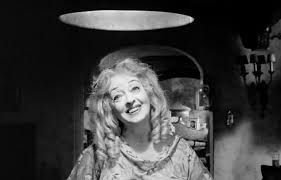 theme of performance. The older ‘Baby’ Jane (played by Davis) performs several times in the film by enacting her old song and dance routine. The film highlights these moments by the staging: a ceiling light acts as a spotlight and Jane/Davis faces front.
theme of performance. The older ‘Baby’ Jane (played by Davis) performs several times in the film by enacting her old song and dance routine. The film highlights these moments by the staging: a ceiling light acts as a spotlight and Jane/Davis faces front.
The theme of Jane performing also plays out as she imitates her sister Blanche. Jane does so mockingly to begin with as she throws a phrase Blanche has just uttered back in her face, but later her imitation is used for the purpose of impersonation. The first time this occurs it is relatively innocent. Alcoholic Jane is annoyed that Blanche has cancelled her account with the local off-license and she successfully fools them into believing they are talking to Blanche on the telephone. Not only does she uncannily imitate Blanche’s voice, but she also, arguably unnecessarily, uses similar facial 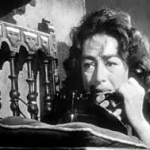 expressions. The second occurrence is far more sinister. Wheelchair-bound Blanche has struggled downstairs and telephoned for help. Once more, Jane manages to convince the person she is talking to (a Doctor in this case) that she is in fact Blanche. Blanche is therefore denied the held she so desperately requires, and struggled so hard to gain access to.
expressions. The second occurrence is far more sinister. Wheelchair-bound Blanche has struggled downstairs and telephoned for help. Once more, Jane manages to convince the person she is talking to (a Doctor in this case) that she is in fact Blanche. Blanche is therefore denied the held she so desperately requires, and struggled so hard to gain access to.
We discussed the way in which Davis effectively portrayed Jane’s switch between the performance of childlikeness (her admittedly deluded, but still slightly detached, enactment of her old song and dance routine) and her regression to childhood. This appeared to be triggered by the cleaner Elvira finding that Jane was keeping Blanche tied up and locked in her room. After attacking and killing Elvira with a hammer, Jane pleads with Blanche to advise her. This is in stark contrast to the control she previously exercised over her sister. Later still, when Jane is concerned with escape, her first thought is to travel to the beach with Blanche. It was noted that both Rain (1932) and Baby Jane end with deaths on beaches: in Rain the reformer Davidson (Walter Huston) commits suicide there, while in Baby Jane Blanche dies due to her sister’s neglect and abuse. We thought this was especially interesting since the beach has been written of as a place of safety, 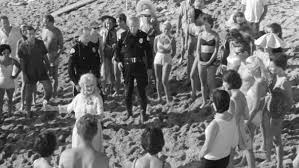 given its relation to childhood, and as a female space. Jane’s delight in obtaining (though significantly not purchasing) ice-creams for herself and Blanche and Davis’ uninhibited performance of Jane’s impromptu old song and dance routine on the beach underlines her regression.
given its relation to childhood, and as a female space. Jane’s delight in obtaining (though significantly not purchasing) ice-creams for herself and Blanche and Davis’ uninhibited performance of Jane’s impromptu old song and dance routine on the beach underlines her regression.
Davis’ use of gestures was also 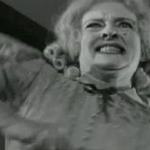 commented on. Many of these are in the service of revealing Jane’s true self – whether as unbalanced tormentor or a frightened child. We might particularly think of the most exaggerated: the relish with which she kicks the helpless Blanche. This was also true of the most exaggerated gestures Davis employed in Of Human Bondage (1934). These occurred during Mildred’s tirade against Philip (Leslie Howard) and
commented on. Many of these are in the service of revealing Jane’s true self – whether as unbalanced tormentor or a frightened child. We might particularly think of the most exaggerated: the relish with which she kicks the helpless Blanche. This was also true of the most exaggerated gestures Davis employed in Of Human Bondage (1934). These occurred during Mildred’s tirade against Philip (Leslie Howard) and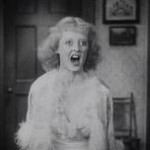 effectively revealed her violent and ugly character. A difference between the characters – Mildred is always performing in some sense while Jane occasionally performs her old song and dance routine – is marked, however. It was also noted that the only way for Davis to successfully play a mentally unbalanced character regressing into childhood was to overplay her.
effectively revealed her violent and ugly character. A difference between the characters – Mildred is always performing in some sense while Jane occasionally performs her old song and dance routine – is marked, however. It was also noted that the only way for Davis to successfully play a mentally unbalanced character regressing into childhood was to overplay her.
There is a further, more subtle level of character performance: the way we all display certain aspects of our character at different times and in varying situations in everyday life. This is less applicable to Davis’ Jane as on the whole she does not appear to be putting on an act: she mostly tells her neighbours, the cleaner Elvira and especially her sister Blanche, exactly what she thinks. Even the insidious way in which Jane causes Blanche to fear eating the meals Jane prepares is due to Jane’s previous grand gestures: the serving up of Blanche’s pet budgerigar and later a rat for dinner.
 Crawford has fewer opportunities than Davis to signal her performance. However, she must often placate the mentally unstable Jane by being less than truthful. Crawford does still have some moments which require extreme reaction. She becomes increasingly persecuted by Jane and fearful of the meals her sister serves. A particularly noteworthy sequence involves both stars. Blanche/Crawford’s scream of horror as she uncovers the
Crawford has fewer opportunities than Davis to signal her performance. However, she must often placate the mentally unstable Jane by being less than truthful. Crawford does still have some moments which require extreme reaction. She becomes increasingly persecuted by Jane and fearful of the meals her sister serves. A particularly noteworthy sequence involves both stars. Blanche/Crawford’s scream of horror as she uncovers the 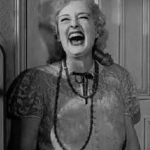 garnished dead rat is followed by Jane/Davis’ hysterical laugher. Jane has waited outside to hear Blanche’s reaction and the juxtaposition of shots and similar sounds effective unites the sisters and the stars. Crawford’s shifting between restraint and a certain level of exaggeration (her fear) was compared to her earlier performance in Rain (1932).
garnished dead rat is followed by Jane/Davis’ hysterical laugher. Jane has waited outside to hear Blanche’s reaction and the juxtaposition of shots and similar sounds effective unites the sisters and the stars. Crawford’s shifting between restraint and a certain level of exaggeration (her fear) was compared to her earlier performance in Rain (1932).
The theme of performance extends to other characters in the film. Pianist Edwin Flag (played by Victor Buono) is first seen at home with his mother, Dehlia, (played by Marjorie Bennet) when she telephones Jane pretending to be her son’s secretary. When Edwin visits Jane he ‘performs’ literally since he accompanies Jane’s singing on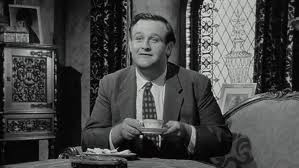 the piano. Performance is also present as he displays a particular side of himself to Jane in the hope that she will employ him. He plays up his Englishness and emphasises his claims to refinement when the two take tea together. Most notable is Edwin’s response to Jane’s routine. He does well to hide his horror at her attempts to sing. Edwin declares that Jane’s act is ‘wonderful’ when the camera’s privileged view of his face suggests he believes precisely the opposite. The audience must, of course, agree with this opinion. While Edwin is forced to listen and watch Jane through his need for paid employment, we find it hard to tear our eyes and ears away from the fascinating and grotesque spectacle: of both Jane and Davis.
the piano. Performance is also present as he displays a particular side of himself to Jane in the hope that she will employ him. He plays up his Englishness and emphasises his claims to refinement when the two take tea together. Most notable is Edwin’s response to Jane’s routine. He does well to hide his horror at her attempts to sing. Edwin declares that Jane’s act is ‘wonderful’ when the camera’s privileged view of his face suggests he believes precisely the opposite. The audience must, of course, agree with this opinion. While Edwin is forced to listen and watch Jane through his need for paid employment, we find it hard to tear our eyes and ears away from the fascinating and grotesque spectacle: of both Jane and Davis.
We also briefly discussed the film’s style. The film often cross-cuts between Jane returning home in her car after running some errands and Blanche’s futile attempts at escape. In addition, Aldrich often signposts the particularly heightened moments of melodrama with an overtly dramatic use of shot choice (notably the zoom) and sound (often non-diegetic music).The scene in which an increasingly frustrated Blanche ineffectually wheels her chair around on the spot is a good example. In order to drive home Blanche’s feelings of confinement, Aldrich switches from a straight-on to an overhead camera angle which better reveals her inability to move far. Another very memorable shot is the one which prompts Jane to break down on the staircase. This depicts Edwin/Buono wheeling a wheelchair through the hall with a blanket over his head and a Baby Jane doll on his lap. In addition to causing Jane to react, it is puzzlingly bizarre in itself, and manages to be conspicuous in a film full of odd moments.
The intended Crawford and Davis follow-up to Baby Jane: Hush…Hush, Sweet Charlotte (1964) also prompted some fruitful reflection. In this the roles of tormentor and tormented as played out in Baby Jane by Davis and Crawford respectively, were meant to be reversed. Before Crawford pulled out and was replaced by Olivia de Havilland, she was set to play Miriam – Charlotte’s (Davis) tormentor. Interestingly the American Film Institute (AFI) defines Hush…Hush as horror rather than melodrama. Though it is certainly true that the boundary between the two is blurred and that Baby Jane itself has elements of horror. (We will be able to explore this more over the next two weeks as we focus on the horror genre.) Baby Jane and Hush…Hush contain other notable similarities. In addition to the planned reteaming of Davis and Crawford another star of Baby Jane appears: Buono intriguingly plays Charlotte’s father in Hush….Hush’s  flashbacks. At the character level we observed the fate of the cleaner/housekeeper in both films. In Baby Jane Blanche’s ally, and cleaner, Elvira (Maidie Norman), is killed by Jane while Velma (Agnes Moorehead) Charlotte’s housekeeper and friend in Hush…Hush… suffers a similar fate.
flashbacks. At the character level we observed the fate of the cleaner/housekeeper in both films. In Baby Jane Blanche’s ally, and cleaner, Elvira (Maidie Norman), is killed by Jane while Velma (Agnes Moorehead) Charlotte’s housekeeper and friend in Hush…Hush… suffers a similar fate.
Of course the off-screen melodrama of Crawford and Davis’ ‘feud’ and their personal difficulties were also a point of discussion. Both Crawford and Davis’ daughters (the latter’s offspring, BD Hyman, played the young neighbour in Baby Jane) wrote autobiographies which contained less than flattering portraits of their mothers. Christina Crawford waited until her mother had died to publish her account, and therefore Joan could not put across her point of view. Davis noted how unfair this was and when Davis’ own daughter published a similar volume Davis was able to retaliate to the accusations in her own memoir This ‘n That.
We ended the session with a brief reference to Davis and especially Crawford in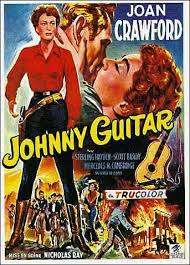 relation to camp. The 60-something Crawford temporarily taking over her ill 20-something daughter’s role in a TV soap is a very good example, while Crawford’s 1954 film Johnny Guitar is notorious for its status as a camp classic. In Nicholas Ray’s film, Crawford feuded on and off-screen with another actress– this time Mercedes McCambridge. We thought it noteworthy that the clip from comedy series Psyhcobitches privileged the notion of camp. It certainly seems that camp, specifically in relation to Baby Jane, is closely attached to Davis and Crawford’s star images in retrospect.
relation to camp. The 60-something Crawford temporarily taking over her ill 20-something daughter’s role in a TV soap is a very good example, while Crawford’s 1954 film Johnny Guitar is notorious for its status as a camp classic. In Nicholas Ray’s film, Crawford feuded on and off-screen with another actress– this time Mercedes McCambridge. We thought it noteworthy that the clip from comedy series Psyhcobitches privileged the notion of camp. It certainly seems that camp, specifically in relation to Baby Jane, is closely attached to Davis and Crawford’s star images in retrospect.
Many thanks to Lies and Ann-Marie for sharing their extensive Joan and Bette knowledge and providing some great competition prizes!
Do, as ever, log in to comment or email me on sp458@kent.ac.uk to add your own thoughts.


Hello again Sarah,
Thanks for your reply and these fruitful thoughts! I think we can definitely widen out the theme of concealment and revelation to the narratives of melodramas more widely as, you say, many of these plots feature a central mystery as a motivating factor for the characters. It is interesting that this has been a trait which has carried over into subsequent weeks with our latest screenings: American Horror Story revolves around the mystery behind the house, whilst Twin Peaks and The X-Files are detective stories.
Coming back to Baby Jane, I think it is also possible to extend your thoughts on the ‘reflexive discussion’ the film offers on performance. It also struck me that Jane’s and Blanche’s acting careers may have ended but they continue to find audiences to perform to. For Blanche this is mainly focused on pretending all is well with Jane at the beginning of the film and lying to protect herself from her increasingly abusive sister. Jane, on the other hand, constantly performs to everyone! She treats Jane with disdain but acts ‘normally’ to the neighbours and the maid. Jane behaves as a star for Edwin but later becomes a vulnerable child in front of both Blanche and the police.
In this way, the film suggests that the sisters – but particularly Jane – are always performing. Coupled with the knowledge we are watching Davis and Crawford perform – both in the film ‘now’ and in past film clips of ‘then’ – I wonder what this says about performance and the star image? Are stars always performing? Indeed, is being a star just another performance? Again it’s an interesting point because, as you mentioned above, Davis called herself an ‘actress’ and Crawford the ‘star’…
Hi Frances, and many thanks for your insightful comments.
I think it is intriguing that the concealment and revelation theme has been a focus of many of our melodrama screenings. I wonder if the way this is approached in melodrama can be usefully compared/contrasted to dramatic narrative techniques more generally . This might mean we can tease out what makes melodrama melodrama…
What you mentioned about stars always performing really struck a chord. In Stars (1979) Dyer quotes Goffmann’s theory that in fact we all play roles in life. Dyer asserts that the fact stars do this too strengthens our connection with them. However, I’d say that the way we all perform in every day life and the way performers enact this is very different. It is noticeable that Davis and Crawford’s characters ‘perform’ the most, but Buono’s Edwin also has many facets.
I think that further investigation as to whether stars are always performing, or perhaps perceived by us to be performing, would be very useful in relation to stars and melodrama.
Posted by Frances
Thanks for such a thorough summary Sarah! I also thought it was interesting to note how the two characters are introduced and/or developed early on to us via their performances, which of course helps to emphasise the melodrama which permeates Jane’s and Blanche’s profession and personal lives: indeed, can we separate the two?! Although performance appears to define Jane and Blanche from the beginning of the film, a comparison of their respective introductions does reveal a slight difference: the very young and slightly older Jane is seen performing straight away, with one very successful appearance on stage as a child and another not-so-well-received film role as an adult. The revelation of Blanche as an actress is of course delayed by the accomplishment of her sister – Blanche’s first appearance in the film is as an unwilling spectator in Jane’s success – but it did strike me that the film delays actually showing us the fruits of Blanche’s later success. Blanche as actress and superior performer in Hollywood is conveyed to us through the extensive conversation of Hollywood producers but we do not actually view this for ourselves until a while later. Consequently, the introduction of Joan Crawford into the film is therefore also delayed. I wonder why this is? This could be related to the fact Crawford has less screen time, comparatively speaking, to Davis. But the difference in the characters’ introductions as actresses does also fit quite nicely with the relationship between melodrama , delay and reticence we have had in previous weeks as well…
Hi Frances, many thanks for your very interesting comments.
There is indeed a difference discernible between the way Jane/Davis and Blanche/Crawford are introduced. I wonder if we might draw this out further – to star entrances in melodrama and film more generally? Rain’s emphatic presentation of Sadie/Crawford’s first appearance is a case in point. And it is notable that Baby Jane differs considerably in that we are treated to two star entrances. Also, rather unusually, these are both female stars.
I also thought the reflexive discussion around film performance within the film was fascinating. Especially the way it related (or did not relate) to what we actually saw. For example, Jane’s (or really Davis’) performance in the film screened in the theatre is said by its producers to be awful. Yet the film clip used is of course Davis in one of her earlier films. I wonder how she felt about that?! And whether Crawford thought this a rather ironic (and welcome!) turn given Davis’ insistence on calling herself an actress and Crawford ‘merely’ a star…
Your relating of the stars’ first appearances to delay and reticence in melodrama is very useful. We can perhaps widen this out too: to the accompanying theme of concealment and revelation we’ve noted in past screenings. The ‘secret’ is often thought to be at the heart of melodramas. At the end of Baby Jane the secret is revealed to be the fact that Blanche in fact caused the accident Jane has always blamed herself for. Though whether Blanche is telling the truth at this point or just trying to win Jane over in order to secure her own survival is debatable.
Do feel free to post some more comments if you want to, and to agree/disagree with mine!
Sarah